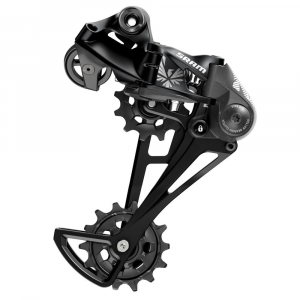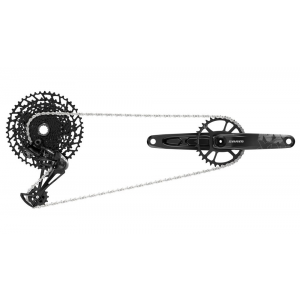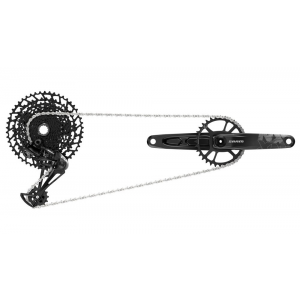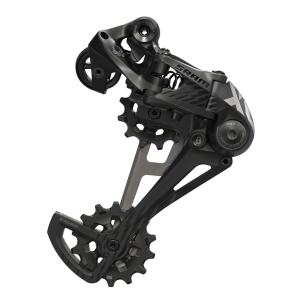SRAM NX Eagle Rear Derailleur
| Where To Buy | |||
|---|---|---|---|
Free shipping on orders over $50 (continental U.S. only).
International shipping available. Some exclusions apply. |
Free shipping on orders over $50 (continental U.S. only).
International shipping available. Some exclusions apply. $99.99
|
||
Free shipping on orders over $50 (continental U.S. only).
International shipping available. Some exclusions apply. |
Free shipping on orders over $50 (continental U.S. only).
International shipping available. Some exclusions apply. $262.40
|
||
SRAM NX Eagle DUB Groupset
$262.40
|
|||

When SRAM launched its single-ring, 11-speed, wide-range drivetrain in the summer of 2012 it took quite a few years for the technology to trickle its way down to the entry level groupsets, and it also took some time for the single-ring revolution to really run its course. With 12-speed Eagle, it’s only been two years, and in that short time frame it seems like it has become the go-to standard for many a bike build, at least when it comes to OEM spec on mid- to high-end models. With Shimano finally joining the 12-speed party, and e*thirteen now making a 12-speed version of its wide-range cassette, SRAM can ill afford to stand still however. So to cover all the bases, Eagle has now trickled all the way down to NX, and we’ve already been able to put in some trail time to figure out how it performs in real life. Read on to find out.
SRAM NX Eagle Highlights
- Completely new rear derailleur incorporating the X-HORIZON design and Type-3 ROLLER BEARING CLUTCH technology, weight: 339g, MSRP: $107 USD / €119
- PG-1230 cassette, 11-50t range, compatible with 8-, 9-, and 10-speed splined driver bodies, made with 8 lightweight, stamped steel cogs and 4 high-strength steel cogs pinned onto an aluminum spider, weight: 615g, MSRP: $100 USD / €110
- NX Eagle Trigger Shifter, aluminum/plastic, stainless steel hardware, MatchMaker X compatible, weight: 112g, MSRP: $42 USD / €38
- NX Eagle Crankset, 6000 series forged aluminum arms, DUB technology BB technology, direct mount steel chainring, weight: 705g (175mm, 32-tooth ring), MSRP: $105-121 USD / €116-135
- NX Eagle Chain, Eagle PowerLock chain connector with FLOW LINK technology, weight: 278g (126 links), MSRP: $26 USD / €29
Initial Impressions
You’d need your eagle eye to spot the differences between NX and GX, if it wasn’t for the graphics giving it away. By using different materials and subtle design changes, SRAM’s goal with NX was to bring the price down to provide a true entry-level offering for those looking to get into the 12-speed game without breaking the bank. Except for the cassette, they’ve manage to keep all the features of the more expensive groups in doing so. X-HORIZON derailleur design, type-3 clutch, trigger shifters, it’s all there.


Looking deeper into the differences between NX and GX Eagle, the main price savings and corresponding weight penalties concern the cassette. In moving to a full steel construction, the PG-1230 cassette has landed at a whopping 615 grams, which is 170 grams more than a GX Eagle cassette. It is also not compatible with SRAM’s XD driver, but fits a standard Shimano splined freehub body instead. As a result, it has to make do with 11 teeth on the smallest cog instead of 10 like on GX and above. For reference, here is summary of how NX Eagle compares to GX Eagle:
- NX Eagle Derailleur: 48g heavier, $3 less expensive
- NX Eagle Cassette: 170g heavier, $95 less expensive, 45 percentage points less range
- NX Eagle Shifter: 10g lighter, $2 less expensive
- NX Eagle Crankset: 84g heavier, $30-64 less expensive
- NX Eagle Chain: 15g heavier, $4 less expensive




$375 for a complete drivetrain of this caliber is not a lot, and we fully expect to see OEM product managers take full advantage for their entry- to mid-level bike models going forward. Since all the components of the Eagle universe are cross compatible, we’d also expect to see quite a bit of mixing and matching going on. We do think that SRAM is missing a trick in not offering the NX Eagle cassette in an XD driver version, but with the added complexity required to manufacture it, it would likely offset any potential cost savings thus rendering the whole exercise useless. In other words, if it’s full 10-50 range you want, a GX Eagle cassette is still the entry level option for you. This also means that you won’t be able to use NX Eagle cassettes to replace your worn out GX Eagle stuff on the cheap, unless you have another wheelset or replacement freehub available. Similarly, customers who buy a bike with a full NX group won’t be able to upgrade the cassette later without also swapping the wheel or the freeehub.


The NX Eagle crankset flies a bit under the radar, but warrants a second look. 705 grams including chainring and BB for an enduro-worthy crankset would have been a class leading number not that many years ago, so to find it here for just over $100 USD is actually pretty impressive. It uses SRAM’s new “DUB” technology, which as anyone who likes to read (or post) snarky remarks on the internet will no doubt remember features a 28.99-mm diameter spindle. The point of the annoyingly precise specification wasn’t to upset forum users but rather to allow SRAM to build a more robust BB that will fit any frame currently on the market. Don’t think of it as a standard, but rather a system that will fit any bike, and you’ll be able to put down your keyboard and go enjoy a ride instead.


To wrap up our initial inspection, the derailleur and shifter look very similar to their GX-level counterparts. The shifter is of course MatchMaker compatible, and the rear derailleur features the larger 14t lower pulley wheel also found on other Eagle derailleurs. What is the point of a derailleur that weighs 48 grams more while only costing $3 less per unit you ask? We can only imagine it has to do with offering a homogeneous build for the OEM market, as there appears to be no other reason for it to exist.
On The Trail
We started our NX Eagle installation with the crankset. The pressfit BB needed for our frame provided a precise fit, and installing the crank requires nothing more than a couple of allen keys – tighten down the main spindle bolt to spec, then take up any side-to-side play in the spindle by hand tightening the adjustable preload collar and you’re good to go. We swapped in a Boost chain ring for our bike, which was an equally simple task; three Torx bolts to undo and the chain ring pops right out. Nothing proprietary, nothing complicated, and nothing to strip out.




Installing the new shifter and derailleur proved fairly straightforward as well. Run the cable, adjust the upper and lower derailleur limiters, tighten the cable and fine tune the indexing as needed with the barrel adjuster on the shifter. The only issue we had with this part of the installation is getting the b-screw tension right. SRAM provides a handy little guide that gives a good starting point, IF you take the time to be precise with it. Set up according to spec, shifting very smooth at the large end of the cassette, but sometimes a bit less crisp around the middle and top end. Our solution is to reduce the b-screw tension slightly to where the shifting is better in the middle, and then live with slightly less smooth action when shifting into the easiest gears. Note that both the GX and NX Eagle drivetrains often turn out to perform better on the trail than they do in the work stand.


SRAM shifting has a very direct and mechanical feel to it, and this carries over to NX Eagle as well. The controls are in the familiar spot, and we’d be hard pressed to pick out NX over GX in a blind test. The high end X01 and XX1 groups have a lighter, smoother feel to them, while NX and GX share a somewhat more “clunky” approach.

On the trail, shifting is positive and direct. You can grab several gears at once when shifting to an easier gear, provided you ease off on the pedal power of course (on this topic, note that there is also an e-bike specific version of the NX Eagle shifter available which only allows for one gear to be shifted at a time). Shifting into a harder gear can be done in rapid succession, made easier and quicker by the short thumb paddle which falls naturally under your thumb and offers a very direct action.

As with GX Eagle, we’ve often found a bit of a “dead spot” in the middle of the cassette where shifting into an easier gear in particular can get hung up. If you are careful with how you set up your derailleur you can pretty much get it to a state where it’s not much of a problem, but this aspect of performance is a bit finicky for sure. Make sure your cable is clean and lubed and that there are no kinks in the cable housing, and also keep the pivot points of the derailleur body itself lubricated in case they get dirty and sticky.


SRAM’s “X-SYNC” chain rings are among the best in the business when it comes to chain retention. The heavily sculpted teeth feature alternating widths to fit perfectly with the chain, which in combination with a clutched derailleur offers good enough chain retention to run without a chain guide in all but the most demanding of circumstances. Specifically, we have found no quantifiable difference in chain retention between GX Eagle and NX Eagle, in testing both with and without chain guides on several bikes. We’ve had the odd chain drop over the course of a couple of months, but we’d have to test specifically back to back to figure out if it’s significantly different to X01 performance for example. We did note that the NX cassette was not happy when back pedaling in the easiest gear on some bikes, it appeared more sensitive to this issue than GX. As for the stiffness of the NX crank arms, we were unable to detect any kind of extra flex or any other sign of running an entry level product here.



Things That Could Be Improved
As we previously alluded to, we think the NX Eagle cassette should be made available in an XD driver version as well, to make this groupset accessible to those who have already invested in that mounting standard or to make it easier to upgrade from. You also miss out on the 10t cog with the NX Eagle cassette, but that will not be an issue for many riders. As it stands, the GX Eagle cassette is the actual entry level cassette if you want the full 10-50t experience.
It is a bit difficult to get both the NX and GX levels of Eagle set up to shift perfectly across the whole cassette, when you get it wrong there can be a little bit of a lag when shifting into harder gears across the middle of the cassette. The NX Eagle cassette also appears to be more sensitive to the chain falling off when back pedaling in the lowest gears.
Long Term Durability
Overall, durability of both GX Eagle and NX Eagle seems to be comparable, although we will obviously need a lot more time on NX to really know what’s up. We will say that both derailleurs are sensitive to how they are adjusted, and they don’t like getting beat up. We’ve had several GX Eagle derailleurs start to act up after minor crashes, not to the point of not working but definitely to the point of inconsistent shifting quality. The old 11-speed stuff seemed much more impervious to being mistreated and would often keep working fine long after you’d expect it to give up the ghost.
What’s The Bottom Line?
Seeing all the 12-speed Eagle technology trickle down to SRAM’s most affordable groupset after just 2 years is a good thing. NX Eagle lets riders get into the 12-speed world for a whole lot less than before, and since all the parts in the Eagle universe are cross compatible, mixing and matching your way to a drivetrain that matches your budget is also becoming easier than ever before. The NX Eagle cassette is heavy and doesn’t work with an XD driver, but other than that, NX Eagle basically manages to give you GX performance on a budget. Shifting can be a bit tricky to set up right, but your reward is enough gear range to tackle any hill without the added complexity of a front derailleur.
More information at: www.SRAM.com.
About The Reviewer
Johan Hjord - Age: 45 // Years Riding MTB: 12 // Weight: 190-pounds (87-kg) // Height: 6'0" (1.84m)
Johan loves bikes, which strangely doesn’t make him any better at riding them. After many years spent practicing falling off cliffs with his snowboard, he took up mountain biking in 2005. Ever since, he’s mostly been riding bikes with too much suspension travel to cover up his many flaws as a rider. His 200-pound body weight coupled with unique skill for poor line choice and clumsy landings make him an expert on durability - if parts survive Johan, they’re pretty much okay for anybody. Johan rides flat pedals with a riding style that he describes as "none" (when in actuality he rips!). Having found most trail features to be not to his liking, Johan uses much of his spare time building his own. Johan’s other accomplishments include surviving this far and helping keep the Vital Media Machine’s stoke dial firmly on 11.
Photos by Johan Hjord
Specifications
X-ACTUATION cable pull ratio
14-tooth X-SYNC lower pulley
Type-3 ROLLER BEARING CLUTCH
CAGE LOCK
52-tooth max capacity
| Where To Buy | |||
|---|---|---|---|
Free shipping on orders over $50 (continental U.S. only).
International shipping available. Some exclusions apply. |
Free shipping on orders over $50 (continental U.S. only).
International shipping available. Some exclusions apply. $99.99
|
||
Free shipping on orders over $50 (continental U.S. only).
International shipping available. Some exclusions apply. |
Free shipping on orders over $50 (continental U.S. only).
International shipping available. Some exclusions apply. $262.40
|
||
SRAM NX Eagle DUB Groupset
$262.40
|
|||




























1 comments
Post a reply to: Tested: SRAM NX Eagle Drivetrain